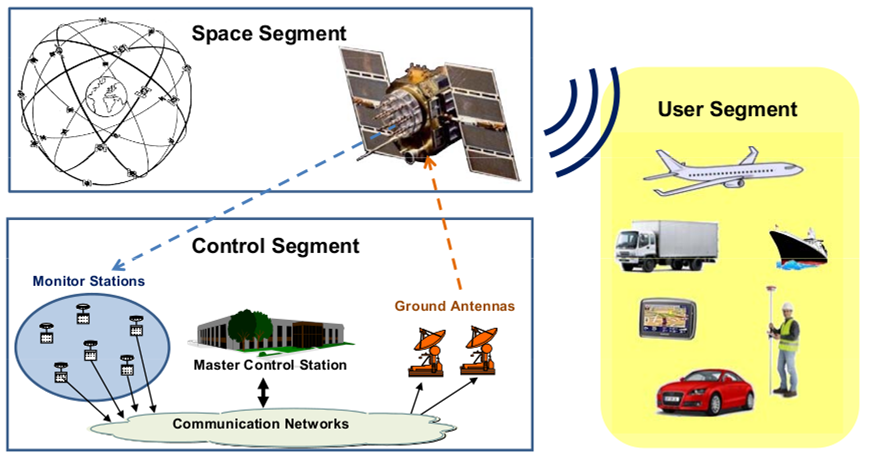Why Isn’t GPS Asset Tracking Utilized Indoors?
Global Positioning Systems (GPS)
Relying on satellite connection, Global Positioning Systems (GPS) provide navigation resources to ground locations of objects and assets. GPS technology was originally implemented by US military forces in the 1960s and has since expanded to the consumer world. GPS technology is integrated in many of the electronics we use daily including smartphones, wearables, and Geographic Information Systems (GIS). GPS architecture is traditionally broken into three segments (Figure 1), consisting of the space segment (satellites), the control/ground segment (monitoring stations), and the user segment (receivers).
Figure 1: GPS architecture is traditionally broken into three segments
Source: European Space Agency Navipedia
GPS Asset Tracking in Indoor Environments
In the scope of asset tracking, GPS technology is a flexible, accurate, and reliable tool that benefits businesses with enhanced real-time monitoring and alerts. Asset tracking applies to how companies track the whereabouts of physical assets within their organization. However, GPS technology has limitations surrounding its use in indoor environments. GPS satellite signals travel via two low-power bandwidths, L1 (1575.42 MHz) and L2 (1227.60 MHz), through line-of-sight transmission. GPS satellite signals can travel through glass, plastic, or clouds but are inhibited by obstacles like mountains and buildings. Additionally, signals can actually be reflected by materials that compose buildings.
Technically, GPS technology can be used in indoor applications when combined with GPS repeater systems in applications like airplane hangars, police stations, tunnels, and bus stations. However, use cases that incorporate GPS repeater systems in indoor environments require solutions that will allow GPS-enabled outdoor assets to be tracked indoors (police radios, airplanes, busses, etc.) There are other methods of connectivity that simplify and enhance asset tracking in indoor environments like LoRa, ultra wide-band (UWB), and beaconing technologies.
GPS Asset Trackers are Ideal for Outdoor Use Cases
GPS technology is an ideal asset tracking solution in outdoor use cases due to its accuracy. In outdoor environments, GPS technology provides the location of assets within 10 to 50 feet accuracy. Comprehensive asset tracking solutions help organizations mitigate loss by preventing theft through real-time location finding. A Market Research Future report cited that, “the Global GPS Tracker Market to attain USD 5.36 Billion in revenue while increasing its growth with a 13.83 % CAGR in the assessment period from 2020-2030.” GPS-enabled asset trackers are ideal for outdoor, mobile use cases like:
- Railway systems integrate GPS technologies as a way to manage and track trains, rail cars, maintenance vehicles, and other equipment. In combination with IoT sensors, GPS technology enhances safety, security, and streamlines operations.
- Although GPS signals cannot penetrate seawater, GPS technology is utilized in the marine industry in a wide range of use cases surrounding asset tracking including commercial fishing fleets and buoy placement.
- The agricultural industry has found GPS asset tracking as a useful method to manage livestock location. Some GPS-enabled livestock trackers mitigate loss by enabling the real-time tracking of herds in geofenced locations and alert farmers through real-time notification of breaches.
Although GPS-enabled asset trackers are most commonly incorporated by asset and fleet managers, GPS asset trackers can locate items of all sizes. From items as small as wearables, bank bags, and laptops to refrigerators, emergency response equipment, and trains, GPS technology can help companies manage benefits through enhanced logistics, safety, productivity, and more.
Symmetry is an expert in IoT and wireless connectivity. Consult with our engineering experts for assistance in building out your asset tracking solution.


.png)